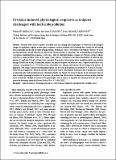Por favor, use este identificador para citar o enlazar a este item:
http://hdl.handle.net/10261/83271COMPARTIR / EXPORTAR:
 SHARE
BASE SHARE
BASE
|
|
| Visualizar otros formatos: MARC | Dublin Core | RDF | ORE | MODS | METS | DIDL | DATACITE | |

| Título: | Predator-induced physiological responses in tadpoles challenged with herbicide pollution |
Autor: | Burraco, Pablo CSIC ORCID; Jiménez-Duarte, Lidia; Gómez-Mestre, Iván CSIC ORCID | Palabras clave: | Corticosterone Glyphosate Inducible defenses Oxidative stress Physiological responses Spadefoot toads |
Fecha de publicación: | 2013 | Editor: | Chinese Academy of Sciences | Citación: | Current Zoology, 59, Issue 4: 475-484 (2013) | Resumen: | Predators induce plastic responses in multiple prey taxa, ranging from morphological to behavioral or physiological changes. In amphibians, tadpoles activate plastic responses to reduce predation risk by reducing their activity rate and altering their morphology, specifically tail depth and pigmentation. Furthermore, there is now evidence that tadpoles' defenses are modified when predators combine with other stressful factors such as pollutants or competitors, but our knowledge on the physiological responses underlying these responses is still scarce. Here we study physiological responses in Pelobates cultripes tadpoles exposed to a natural predator (larvae of the aquatic beetle Dytiscus circumflexus), non-lethal concentrations of herbicide (glyphosate, 0.5 mg/L and 1.0 mg/L) or both factors combined. We measured corticosterone levels, standard metabolic rate, oxidative damage (TBARS) and activity of antioxidant enzymes, and immune response (via leukocyte count). Tadpoles reduced their corticosterone concentration by ca. 24% in the presence of predator cues, whereas corticosterone did not change in the presence of glyphosate. Two enzymes involved in antioxidant response also decreased in the presence of predators (14.7% and 13.2% respectively) but not to glyphosate. Herbicide, however, increased the number of neutrophils and reduced that of lymphocytes, and had an interaction effect with predator presence. Standard metabolic rate did not vary across treatments in our experiment. Thus we show a marked physiological response to the presence of predators but little evidence for interaction between predators and low levels of herbicide. Multiple assessment of the physiological state of animals is important to understand the basis and consequences of phenotypic plasticity | URI: | http://hdl.handle.net/10261/83271 | ISSN: | 1674-5507 |
| Aparece en las colecciones: | (EBD) Artículos |
Ficheros en este ítem:
| Fichero | Descripción | Tamaño | Formato | |
|---|---|---|---|---|
| Curr Zool 2013.pdf | 507,56 kB | Adobe PDF |  Visualizar/Abrir |
CORE Recommender
Page view(s)
284
checked on 23-abr-2024
Download(s)
274
checked on 23-abr-2024
Google ScholarTM
Check
NOTA: Los ítems de Digital.CSIC están protegidos por copyright, con todos los derechos reservados, a menos que se indique lo contrario.
